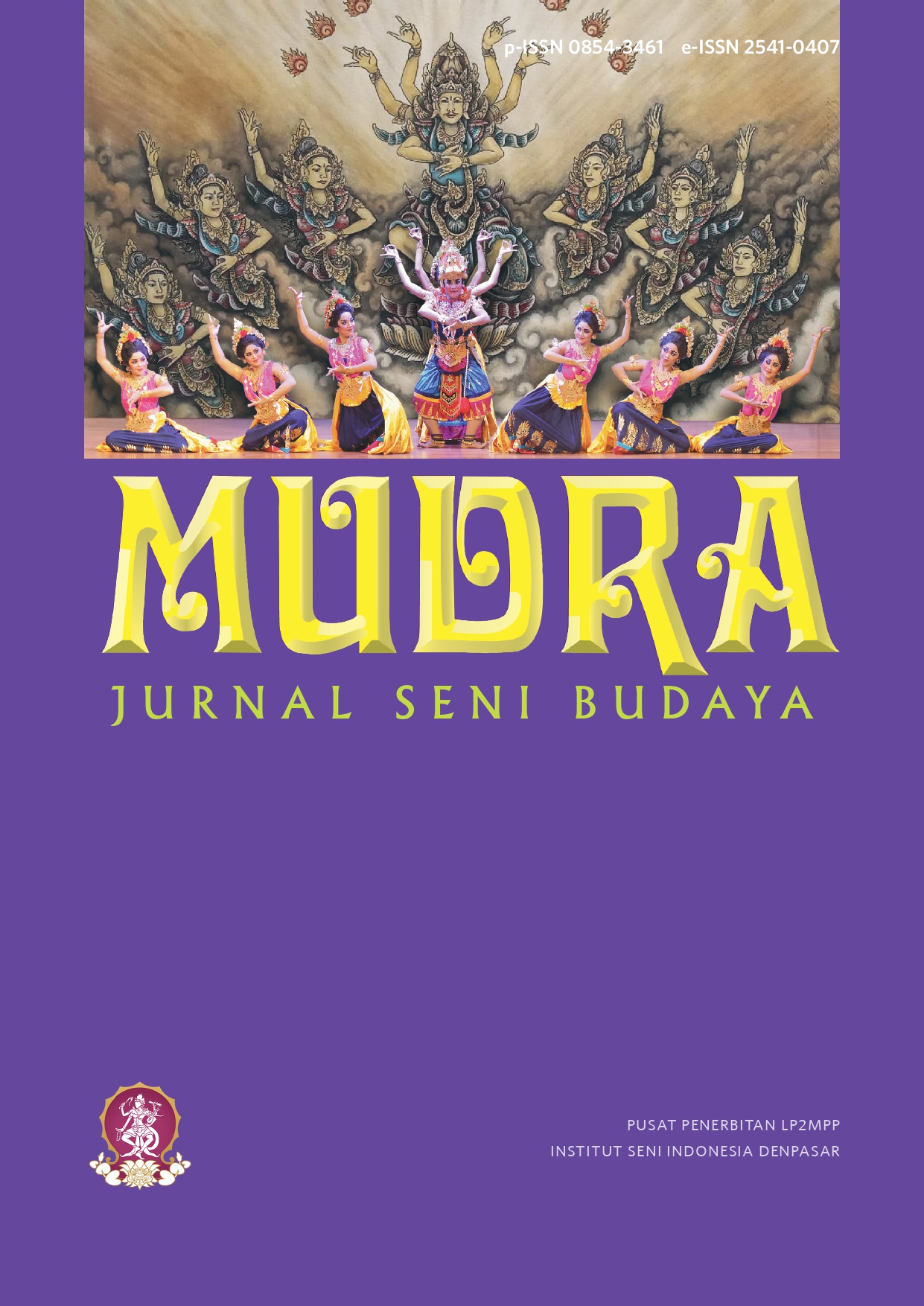Digital Photographies of Silek Rantak Kudo Dance : The West Sumatra Folklore Preservation
DOI:
https://doi.org/10.31091/mudra.v40i3.3087Keywords:
Visual Folklore;, Photography;, Silek Rantak Kudo;, West Sumatra;, Dance;Abstract
The Silek Rantak Kudo Dance, a rich expression of Indonesian folklore and cultural identity—particularly in West Sumatra—requires preservation. To support this effort, a photographic experiment was conducted to explore visual representations capable of conveying the folkloric elements embedded in the dance. Notably, there is a lack of scholarly literature on dance photography in Indonesia, making this study a pioneering contribution to the field. The experiment produced 66 photographs of the Silek Rantak Kudo Dance, with 10% selected for inclusion in a questionnaire aimed at evaluating whether respondents could effectively perceive the folkloric content. This research employed Visual Arts-Based Research Practices, with data collected through a literature review and questionnaires completed by 396 participants. Findings indicate that dance photography of Silek Rantak Kudo should emphasize traditional elements in both movement and visual representation to ensure its recognition as a traditional West Sumatran art form. Furthermore, the study demonstrates that photographic techniques—such as motion photography and posed imagery—can serve as effective tools for promoting and preserving the dance on social media among the Indonesian public.
Downloads
References
R. M. Soedarsono, Tari Tradisional Indonesia. Jakarta: Yayasan Harapan Kita BP3, 1996.
S. L. Candrawati, “Fungsi Seni Tari Tradisional di Indonesia.”
J. L. M. Desfiarni, Toruan, Seni Budaya. 2009.
Vannisa, “Tarian Sumatera Barat Minangkabau,” 2018. https://perpustakaan.id/tarian-sumatera-barat/
T. M. E. Wanda, “Seni Tradisional Rentak Kudo Masyarakat Adat Hamparan Rawang Kerinci 1968-2000,” 2019.
L. Candra, Pepi. Zulfa. Ersi, “Amlis Penari Tradisional Kesenian Rantak Kudo di Pesisir Selatan (Tahun 1992-2015),” J. Ilm. Mhs. STKIP PGRI Sumatera Barat.
Nerosti, “Tiga Gaya Tari Rantak Kudo Berpotensi sebagai Sajian Pariwisata di Kawasan Mandeh dan Sekitarnya,” J. Urban Soc. Art, vol. 4, no. 2, 2017, doi: https://doi.org/10.24821/jousa.v4i2.2162.
M. Andreas, Boyke Bobbi, Tulus, “Studi Terhadap Adanya Dua Versi Rentak Kudo Untuk Acara Pernikahan di Desa Rawang. E-Jurnal Sendratasik FBS Universitas Negeri Padang.,” E-Jurnal Sendratasik FBS Univ. Negeri Padang., vol. 2, no. 1, 2013.
F. Boas, The Mind of Primitive Man. New York: Free Press, 1963.
Koentjaraningrat, Sejarah Teori Antropologi I. Jakarta: Penerbit Universitas Indonesia., 1981.
M. Reason, “Still Moving: The Revelation or Representation of Dance in Still Photography. Dance Research Journal,” 2004, doi: 10.1017/S0149767700007567.
G. and G. L. Kirkland, Dancing on my Grave: An Autobiography. New York: Doubleday & Company Inc., 1986.
K. J. Lack, “Capturing Dance: The Art of Documentation (An Exploration of Distilling The Body in Motion),” 2012. https://ro.ecu.edu.au/theses_hons/77 (accessed Mar. 30, 2020).
P. T. W. Candi, “Dance performances in Borobudur relief,” 2017. https://borobudurpark.com/en/dance-performances-borobudur-relief/ (accessed Apr. 06, 2020).
S. E. Kapti, “Relief Candi Plaosan Lor, Sebagai Sumber Pengembangan Pose Gerak Tari.,” 2013.
S. H. Malini and D. A. A. Prasetyo, “Menengok Tarian Perang dan Nilai Kepahlawanan dalam Naskah Pratèlan Bêksa Wirèng Karna Tandhing Kaliyan Janaka,” Jumantara J. Manuskrip Nusant., vol. 9, no. 2, p. 163, Aug. 2019, doi: 10.37014/jumantara.v9i2.248.
et al. D’Amboise, J., L. Spain, A Guide to Dance Films and Videos Dance on Camera. New York: The Scarecrow Press Inc.
Efrida, “Kontribusi Silat Tuo dalam Tari Rantak Karya Gusmiati Suid,” GELAR J. Seni Budaya, vol. 11, no. 2, 2013, doi: 10.33153/glr.v11i2.1453.
B. Kussudiardjo, Tentang Tari. Yogyakarta: Nur Cahya, 1981.
J. J. Martin, The modern dance. Brooklyn: Dance Horizons, 1965.
Tobroni, Relasi Kemanusiaan dalam Keberagaman (Mengembangkan Etika Sosial Melalui Pendidikan). Bandung: Karya Putra Darwati., 2012.
H. M. . Nahak, “UPAYA MELESTARIKAN BUDAYA INDONESIA DI ERA GLOBALISASI,” J. Sosiol. Nusant., vol. 5, no. 1, pp. 65–76, Jun. 2019, doi: 10.33369/jsn.5.1.65-76.
S. K. Indonesia, Strategi Kebudayaan Indonesia. Jakarta, 2019.
A. Dundes, The Study of Folklore. London: Prentice Hall, 1965.
J. Danandjaya, Folklor Indonesia. Jakarta: Pustaka Grafiti, 1986.
and A. B. P. Provenzo, Eugene F., John Renaud, Encyclopedia of the social and cultural foundations of education. London: Sage Publications, 2009.
Dharsono, “Batik Klasik: Aspek, Fungsi, Filosofi, dan Estetika Batik dalam Pandangan Budaya Nusantara,” Budaya Nusant. Budaya, vol. 1, no. 1, 2014.
R. Sumaryadi dan Wiharsih, Modul Pembelajaran Kajian Folklor. Yogyakarta: Universitas Negeri Yogyakarta.
Koentjaraningrat, Pengantar Ilmu Antropologi. Jakarta: Rineka Cipta, 2009.
S. Murgiyanto, “Minangkabau Dance Redefined: 1968 – 1971,” New York University, 1991.
Sumiarti, “Upaya Pewarisan Tari Rantak Kudo dalam Masyarakat Nagari Lumpo Kabupaten Pesisir Selatan,” 2012. http://repository.unp.ac.id/id/eprint/1508
Sumiarti, “Upaya Pewarisan Tari Rantak Kudo dalam Masyarakat Nagari Lumpo Kabupaten Pesisir Selatan,” 2012. http://repository.unp.ac.id/id/eprint/1508 (accessed Apr. 04, 2020).
and L. M. Rustiyanti, Sri, Fatimah Djajasudarma, Endang Caturwati, “Estetika Tari Minang dalam Kesenian Randai Analisis Tekstual-Kontekstual,” Panggung, vol. 23, no. 1, pp. 153–161, 2013, doi: 10.26742/panggung.v23i1.86.g86.
S. Rustiyanti and W. Listiani, “Visualisasi Tando Tabalah Penari Tunggal dalam Photomotion Pertunjukan Rampak Kelompok Tari Minang,” Mudra J. Seni Budaya, vol. 32, no. 2, Sep. 2017, doi: 10.31091/mudra.v32i2.112.
L. Candra, Pepi. Zulfa. Ersi, “Amlis Penari Tradisional Kesenian Rantak Kudo di Pesisir Selatan (Tahun 1992-2015),” J. Ilm. Mhs. STKIP PGRI Sumatera Barat, 2017.
Y. Welli, "Pewarisan Tari Rentak Kudo Dalam Masyarakat Kemantan Kebalai," Universitas Negeri Padang, 2008.
R. Fauzan and N. Nashar, "Mempertahankan Tradisi, Melestarikan Budaya : Kajian Historis dan Nilai Budaya Lokal Kesenian Terebang Gede di Kota Serang," J. Candrasangkala Pendidik. Sej., vol. 3, no. 1, p. 1, May 2017, doi: 10.30870/candrasangkala.v3i1.2882.
Khayam, Seni, Tradisi, Masyarakat. JakartaSinar Harapan: Sinar Harapan, 1981.
J. Danandjaja, Folklore Indonesia. Jakarta: PT. Temprint, 1986.
A. W. Widjaja, Manusia Indonesia: individu keluarga dan masyarakat. Jakarta: Akademika Pressindo.
R. Jacobus, Sistem Sosial Budaya Indonesia : Suatu Pengantar. Bandung: Ghalia Indonesia, 2006.
P. Leavy, Method Meets Art, Art Based Research Practice. New York: The Guilford Press, 2015.
W. A. Ewing, Breaking Bounds The Dance Photography of Lois Greenfield. London: Thames and Hudson., 1992.
G. Holm, Photography as a research method: The Oxford handbook of qualitative research. New York: Oxford University Press, 2014.
A. M. Hawkins, Creating Through Dance. New Jersey: Princeton Book Company, 1988.
C. Holt, Art in Indonesia: continuities and change. Ithaca: Cornell University Press, 1967.
Downloads
Published
How to Cite
Issue
Section
License
Copyright (c) 2025 Sri Rustiyanti, Wanda Listiani, Anrilia E.M. Ningdyah, Sriati Dwiatmini, Suryanti

This work is licensed under a Creative Commons Attribution-NonCommercial-ShareAlike 4.0 International License.
- Copyright on any open access article in a journal published by Mudra Jurnal Seni Budaya is retained by the author(s).
-
The Creative Commons Attribution License 4.0 formalizes these and other terms and conditions of publishing articles.










